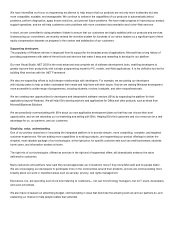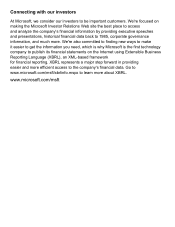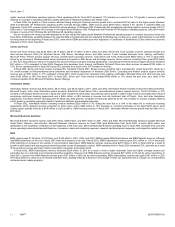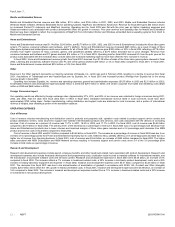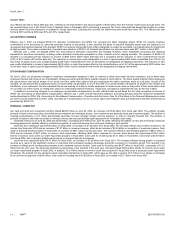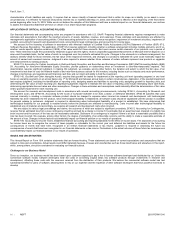Microsoft 2003 Annual Report Download - page 19
Download and view the complete annual report
Please find page 19 of the 2003 Microsoft annual report below. You can navigate through the pages in the report by either clicking on the pages listed below, or by using the keyword search tool below to find specific information within the annual report. MSFT 2003 FORM 10-K
6 /
Part I, Item 1
distributed client/server environments include Oracle, IBM, Computer Associates, Sybase, and Informix. There are also a number of Open Source server
applications available.
Numerous commercial software vendors offer competing commercial software applications for connectivity (both Internet and intranet), security, hosting, and e-
business servers. Additionally, IBM has a large installed base of Lotus Notes and cc:Mail, both of which compete with our collaboration and email products. There
are also a significant number of Open Source software products that compete with Microsoft solutions, including Apache Web Server.
The Open Source model of Linux and other server programs enables both services and hardware companies to provide customers with Open Source software
at nominal cost and earn revenue on complimentary services and products, without having to bear the full costs of research and development for the Open Source
software. For example, IBM, with the largest hardware and services businesses in the industry, promotes Linux extensively and seeks to earn revenues and profits
on the sale of its consulting services to implement the Linux server solution as well as related hardware and commercial software products that run on Linux.
Our developer products compete against offerings from BEA Systems, Borland, IBM, Macromedia, Oracle, Sun Microsystems, Sybase, and other companies.
We believe that our server products provide customers with significant advantages in innovation, performance (both relative to total costs of ownership and in
absolute terms), productivity, applications development tools and environment, compatibility with a broad base of hardware and software applications, security,
and manageability.
Information Worker
While we are the leader in business productivity software applications, competitors to the Microsoft Office System include many software application vendors, such
as Apple, Corel, IBM, Oracle, QUALCOMM, Sun Microsystems, and local application developers in Europe and Asia. IBM and Corel have significant installed
bases with their spreadsheet and word processor products, respectively, and both have aggressive pricing strategies. Also, Apple and IBM preinstall certain of
their application software products on various models of their PCs, competing directly with our applications. Corel’s suite and Sun Microsystems’ Star Office are
aggressively priced and attractive for OEMs to pre-install on low-priced PCs. The OpenOffice.org project provides a freely downloadable cross-platform application
that is gaining popularity in certain market segments. In addition to traditional client-side applications, web-based applications hosting services such as SimDesk
provide an alternative to Microsoft Office and are gaining some support. We believe that our products compete effectively by providing customers significant
benefits, such as easy-to-use personal productivity, support for effective teaming and collaboration, and better information management and control.
Microsoft Business Solutions
The small and mid-market business applications market globally is highly fragmented and is intensely competitive in all sectors. We face competition from a large
number of companies in this business. Well-known vendors focused on small and mid-market business, such as Intuit and Sage, compete against us for a portion
of this segment. In addition, large-enterprise focused vendors, such as Oracle, Peoplesoft and SAP, also compete against us for a portion of this segment.
However, the competition for a significant majority of the total business applications market includes thousands of much smaller vendors in specific localities or
industries who offer their own enterprise resource planning, customer relationship management, and/or analytic solutions.
MSN
MSN competes with AOL-Time Warner, Google, Yahoo!, and a vast array of Web sites and portals that offer content of all types, such as email, instant messaging,
calendaring, chat, search, and shopping services. As the broadband access market grows, we expect to have increasing opportunity to deliver premium
subscription services for consumers. AOL and Yahoo! are both pursuing similar strategies and will be competitors in this emerging category. While the movement
to broadband access may cause our Internet Access dial-up business to continue to decline, we will strive to convert customers to MSN premium subscription
services via partnerships with network providers and Internet software services offered directly from MSN. We believe our strengths are our heritage of technology
innovation, particularly in communication services, distribution partnerships, and the large base of users of our free MSN Network. Additionally, while our
advertising business has grown considerably over the last year, evolving market conditions, particularly paid search, will impact our strategy over the next year.
We currently are building our own search engine and investing to support the continued growth of our advertising business.
Mobile and Embedded Devices
Windows Mobile software faces substantial competition from Nokia, Openwave Systems, PalmSource, QUALCOMM, and Symbian. The embedded operating
system market is highly fragmented with many competitive offerings. Key competitors include IBM, Wind River, and versions of embeddable Linux from
commercial Linux vendors, such as Metrowerks and MontaVista Software. MapPoint competitors include DeLorme, MapInfo, Mapquest.com, Rand McNally,
Webraska Mobile Technologies, and Yahoo!. The telematics market is also highly fragmented, with competitive offerings from IBM and automotive suppliers
building on various real-time operating system platforms from commercial Linux vendors, QNX Software Systems, Wind River, and others.
Home and Entertainment
The home and entertainment business is highly competitive and is characterized by limited platform life cycles, frequent introductions of new products and titles,
and the development of new technologies. The markets for our products are characterized by significant price competition, and we anticipate continued pricing
pressure from our competitors. These pressures have, from time to time, required us to reduce prices on certain products. Our competitors vary in size from very
small companies with limited resources to very large, diversified corporations with substantial financial and marketing resources. We compete primarily on the
basis of price, product quality and variety, timing of product releases, and effectiveness of distribution and marketing.


